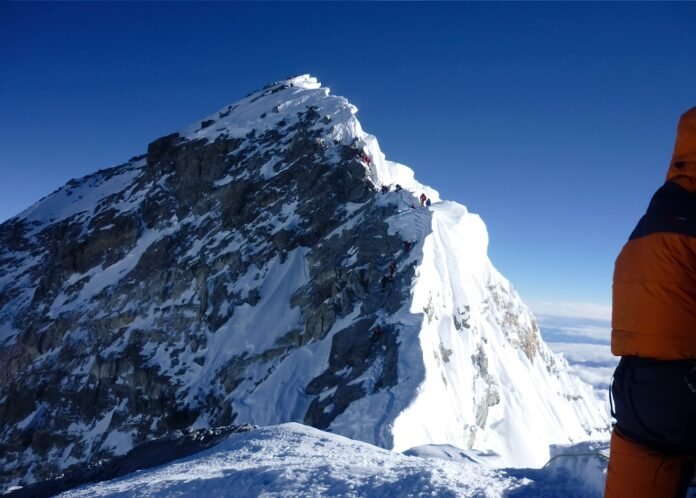The spring climbing season on Mount Everest has commenced in Nepal, marking the beginning of a period when mountaineers from around the world flock to the world’s highest peak in pursuit of their summit dreams. As climbers embark on their expeditions, the reopening of the Tibetan route by China offers an additional pathway for adventurers to reach the summit.
Mount Everest, standing at an awe-inspiring height of 8,848.86 meters (29,031.7 feet) above sea level, has long captivated the imagination of adventurers and climbers. The spring climbing season, which typically spans from late April to early June, provides favorable weather conditions for mountaineers to attempt the ascent.
Nepal, home to the southern route to Everest’s summit, serves as a hub for climbers and expedition teams preparing for their journey. The country’s vibrant mountaineering community and well-established infrastructure support the influx of climbers during the spring season.
Meanwhile, China’s decision to reopen the Tibetan route offers climbers an alternative route to reach the summit. The Tibetan route, also known as the North Col route, provides a challenging yet rewarding ascent to Everest’s summit from the northern side of the mountain.
The reopening of the Tibetan route comes after a hiatus due to the COVID-19 pandemic, which had temporarily disrupted international travel and mountaineering activities. With travel restrictions easing and vaccination efforts underway, climbers now have the opportunity to pursue their Everest dreams via the Tibetan route once again.
As climbers set out on their expeditions, safety remains a top priority for both Nepali and Chinese authorities. Mount Everest, despite its allure, presents numerous risks and challenges, including treacherous terrain, extreme weather conditions, and altitude-related health concerns.
Both Nepal and China have implemented measures to ensure the safety and well-being of climbers during the spring climbing season. This includes providing essential support services, such as medical assistance, rescue operations, and logistical support, to climbers and expedition teams.
As the spring climbing season unfolds, climbers from diverse backgrounds and nationalities will converge on Everest’s slopes, each with their own aspirations and motivations. For some, reaching the summit represents the fulfillment of a lifelong dream, while for others, it is a test of endurance, skill, and determination.
As climbers embark on their expeditions during the Everest spring climbing season, they face a myriad of challenges and uncertainties along the way. The journey to the summit is fraught with risks, from avalanches and crevasses to altitude sickness and unpredictable weather patterns. Climbers must contend with the physical and mental demands of high-altitude mountaineering, pushing their bodies to the limit in pursuit of their goal.
Despite the inherent dangers, the allure of Mount Everest remains undiminished, drawing adventurers from all corners of the globe to test their mettle against the world’s tallest peak. For many climbers, the journey is as much about personal growth and self-discovery as it is about reaching the summit. The harsh and unforgiving environment of Everest serves as a crucible in which individuals are forced to confront their fears, overcome obstacles, and tap into reservoirs of inner strength they never knew they possessed.
The reopening of the Tibetan route by China adds a new dimension to the Everest climbing experience, offering climbers an alternative path to the summit and diversifying their options for exploration. The North Col route presents its own set of challenges, including technical climbs, steep slopes, and exposure to high winds and cold temperatures. However, for those willing to brave the rigors of the Tibetan side, the rewards are immense, with sweeping views of the Himalayas and a sense of accomplishment that comes from conquering one of the world’s most formidable mountains.
As climbers ascend Everest’s slopes, they become part of a rich tapestry of mountaineering history, joining the ranks of legendary explorers and adventurers who have left their mark on the mountain. From the pioneering expeditions of Sir Edmund Hillary and Tenzing Norgay in 1953 to the modern-day feats of endurance and perseverance, Everest has been a beacon of inspiration for generations of climbers.
The spring climbing season also serves as a reminder of the fragile ecosystem that surrounds Mount Everest and the need for sustainable practices in mountaineering. As climbers navigate the mountain’s pristine landscapes, they must tread lightly and minimize their impact on the environment, respecting the delicate balance of nature that sustains life in the Himalayas.
The start of the Everest spring climbing season heralds a period of excitement, adventure, and discovery for climbers around the world. Whether scaling the southern route from Nepal or tackling the northern route from Tibet, each ascent of Everest is a testament to the human spirit’s indomitable will and the enduring allure of the world’s tallest peak. As climbers set out on their journeys, they carry with them the hopes and dreams of countless adventurers who have come before them, forging new paths and writing their own chapters in the annals of mountaineering history.

